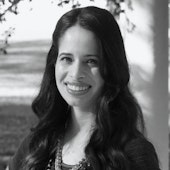There is no question that American policymakers and power structures have often prioritized English proficiency to the exclusion of other languages—particularly as English has become a global lingua franca. Indeed, linguistic diversity in the United States is regularly targeted during periodic waves of U.S. anti-immigrant sentiments and corresponding political crusades. It’s perhaps no wonder the country remains “stubbornly monolingual.”
But this push towards English-only monolingualism is only one part of the American language story. North America has played host to hundreds of languages over the centuries, before—and since—the United States existed as a country. Thanks to the United States’ enviable position as a global destination for immigrants, the country can count on millions of multilingual Americans speaking indigenous, Latin American, European, Asian, African, and other languages.
As a result, America’s present is multilingual and multicultural. Linguistic diversity is growing in U.S. schools—just as it has in prior historical periods. More than 20 percent of U.S. kids speak a non-English language at home, one in four children is a child of immigrants, and more than five million students are currently classified as English learners (ELs).1
What of America’s future? Whether we make the most of this exciting moment depends on how well U.S. schools, society, and policymakers embrace these children’s bilingualism. A 2017 report on languages in U.S. schools and society published by the American Academy of Arts and Sciences put it best:
It is critical that we work together at this moment in history, when there is so much to gain by participating in a multilingual world, and so much to lose if we remain stubbornly monolingual.2
Benefits of Bilingualism
Research shows that there are personal, social, academic, economic, and political benefits to embracing bilingualism from linguistically diverse children’s earliest years.
Children who speak a non-English language at home—and are able to fully develop their emerging bilingualism—can maintain stronger connections with their families and heritage, and have stronger cross-cultural connections that expand their social networks.3 These social benefits of bilingualism are evident early, with studies showing that bilingual preschoolers have better socio-emotional development and greater conflict-resolution skills.4
Bilinguals also gain cognitive advantages. For instance, because bilinguals learn to constantly, actively use their brains to inhibit one language and activate the other language, they gain additional cognitive abilities earlier than monolingual peers—such as more efficient switching between tasks and better abilities to focus. In one study, bilingual infants recognized when something new was quickly introduced to their environment.5 Amazingly, this cognitive advantage is seen in bilingual infants starting at seven months old.6 Other research shows that bilingual children outperform monolingual children on tests requiring problem solving and working memory.7 These cognitive advantages are seen later in life too. For bilinguals, Alzheimer’s disease may have a delayed onset of 5.5 years, because bilingualism appears to protect key neural pathways in the brain.8
When English learners (ELs) receive high quality dual-language instruction, they also show impressive academic advantages. ELs who receive bilingual instruction have, on average, stronger academic outcomes, better English-language acquisition trajectories, and stronger bilingual skills than those who only receive English instruction.9 Moreover, for ELs, the positive academic impact of dual-language instruction is long-lasting. Research studies have found that ELs who attend a dual-language program in preschool or kindergarten are more likely to be proficient in English by middle school.10 One study found that the majority of children who completed a K–5 Spanish–English dual-language immersion program continued taking advanced placement Spanish classes in high school, and nearly half earned the Seal of Biliteracy, which recognizes students who have achieved proficiency in at least two languages.11 What’s more, these students also performed similarly or higher in English Language Arts and math than peers in the same school who did not receive dual-language instruction at an early age. These findings show the importance of providing ELs with high-quality dual-language instruction.
The benefits of bilingualism grow with children into adulthood. In our rapidly expanding global society, there is greater demand for bilingual job candidates: nine out of ten U.S. employers reported that they rely on bilingual employees, 56 percent indicated that there will be greater demand for bilingual employees in the next five years, and one in four lost business due to a lack of bilingual staff.12 Research has also found that Spanish-speaking Latinos, in particular, who maintained their bilingualism were more likely to attend a four-year college, which eliminates the need to transfer and increases the likelihood of degree attainment.13 Studies conducted in the last decade also find that individuals who become “balanced bilinguals,” or those who develop both their home language and English well, make on average over $5,000 a year more than their peers who lose their home language and speak exclusively in English as adults.14 For the United States to be competitive in our increasingly global market, fostering the bilingualism of its citizens is fundamental to remaining responsive to both the economic challenges and opportunities of the twenty-first century.
For the United States to be competitive in our increasingly global market, fostering the bilingualism of its citizens is fundamental to remaining responsive to both the economic challenges and opportunities of the twenty-first century.
Finally, bilingualism is also beneficial to a democratic society. The United States is linguistically, culturally, and racially diverse: embracing bilingualism can include and engage a greater number of people in the democratic process. Growth in the number of people speaking languages in addition to English creates new opportunities for greater cross-cultural understanding, and integrates different ideas and perspectives in ways that will improve American democratic discourse.
Bilingual Bright Spots
American enthusiasm for bilingual education—and bilingualism more generally—is unmistakably growing. Decades-old bans on bilingual instruction for linguistically diverse children were recently repealed in California and Massachusetts, and pressure for a similar move is growing in Arizona.15 Evidence suggests that family demand for dual-language immersion programs is often greater than the supply of seats—from Washington, D.C. to Gwinnett County, Georgia, to Portland, Oregon, and in hundreds of communities in between.16
Dual-language immersion programs offer academic instruction in two languages—the most effective of these appear to be “two-way” dual-language immersion schools that enroll roughly equal shares of native speakers of English and native speakers of the program’s non-English partner language. This bilingual education model is growing in states around the country. A 2021 American Councils Research Center survey found more than 3,600 such programs across the country, while DualLanguageSchools.org reports nearly 4,900.17 In recent decades, states like North Carolina, Utah, and Delaware have invested significant new grant money in expanding access to dual-language programs. Texas has reweighted its core education funding formula to provide systemic support for districts converting their bilingual education programs to dual-language models.18 California recently awarded $10 million in grants to schools and districts, with the goal of adding fifty-five new dual-language schools across the state.19 As part of a multi-year statewide push to increase public education investment, Maryland lawmakers are considering an annual $10 million boost to provide districts with additional funds dedicated to growing dual-language programs across the state.20
Local leaders are also embracing bilingualism. Dallas Independent School District uses dual-language immersion programs as its default language instructional program for ELs. Nearly 70 percent of the district’s 64,217 ELs were enrolled in dual-language schools in 2019–20. Meanwhile, the District of Columbia enrolls fully 30 percent of its ELs in dual-language programs, a higher share than any state. Local leaders in New York City; Los Angeles; Portland, Oregon; Gwinnett County, Georgia;, San Antonio; and beyond are committing to bilingualism and biliteracy through dual-language schooling.21
This upswell in interest has garnered some meaningful national attention. In a January 2023 address, U.S. Secretary of Education Miguel Cardona named multilingualism as a core priority for the U.S. Department of Education, explaining, “Learning another, or multiple languages should be expected of our students and anchored as a skill that will enhance their global engagement and increase opportunities for success.”22 A month later, the department put concrete support behind this goal, announcing a dozen new grants for teacher training programs that committed to expand their bilingual or multilingual teacher training pathways.23
Meanwhile, forty-nine states and the District of Columbia have adopted their own versions of a Seal of Biliteracy.24 The Seal celebrates students’ accomplishment of becoming fully bilingual and biliterate and serves as a signal to institutions of higher education and potential employers. In some places, this award is recognized as equivalent to post-secondary language education credits.
Recommended Policies for Fostering a Polyglot Future
This burst of linguistic and cultural diversity provides the United States with enormous educational, cultural, and economic opportunities. To seize them, schools must grow access to bilingual learning settings—particularly linguistically integrated two-way dual-language immersion programs. Research makes clear that these are the optimal way to advance the linguistic and academic development of ELs—and they have the additional benefit of promoting social integration between ELs and English-dominant, monolingual peers. By centering the value of all students’ languages and cultures, dual-language immersion programs make the many benefits of diversity vivid for all families, including privileged, white, English-dominant parents.
By centering the value of all students’ languages and cultures, dual-language immersion programs make the many benefits of diversity vivid for all families
Here are some crucial ways that policymakers can support the development of the multilingual populace that our country needs.
Invest in Bilingual Teacher Training Pathways
As it stands, our disproportionately white and monolingual U.S. teacher workforce remains an obstacle, as it lacks the capacity to significantly expand bilingual programming.25 Local, state, and federal leaders should prioritize investments in growing bilingual teacher training pathways. If done well, this will serve as a healthy reinforcement loop: each new bilingual teacher trained will make it easier to add new dual-language immersion seats that grow the language abilities of the coming American workforce, which will simultaneously make it easier to staff still more dual-language immersion programs in the longer term.
There are a bevy of policy reforms that would help diversify the American teaching force (many of which were outlined in The Century Foundation’s 2021 report, “A New Federal Equity Agenda for Dual Language Learners and English Learners”).26 Strategies will not be identical from community to community. However, all policymakers should find ways to pursue this goal. Here are two ways we can dedicate the support necessary for developing bilingual education and bilingualism in U.S. society:
1. Federal leaders should fund competitive grant programs for alternative and traditional teacher training programs to expand the number of bilingual teacher candidates they produce each year.27
2. State and local leaders should launch alternative teacher training and licensure options that allow bilingual teacher candidates to more easily join the profession, such as “grow-your-own” programs that help bilingual paraprofessionals and teachers assistants to become fully-credentialed teachers.
Preserve Fair Access to Dual-Language Immersion for Emerging Bilingual Students
As these programs grow, policymakers must prioritize the enrollment of linguistically diverse students with emerging abilities in non-English languages. This begins with ELs, but also should include young bilingual students who are growing up speaking multiple languages in their homes and communities (and who may not be formally classified as ELs).
Dual-language immersion programs vary greatly by location, and the structures required to grow diverse, equitable learning environments will necessarily reflect that reality. In some communities, it will be key to establish enrollment structures that protect fair access for students who speak non-English languages at home. However, communities with high percentages of ELs, like Dallas, may want to encourage greater enrollment from English-dominant students—to create more linguistically integrated two-way programs.
Here are four important steps to fostering the strong and accessible programs we need:
1. Federal leaders should release guidance with maximally specific definitions of one-way dual-language immersion and two-way dual-language immersion.
2. Federal leaders should invest in research and technical assistance to identify best practices for supporting ELs’ emerging bilingualism through dual-language immersion programs.
3. State leaders should increase public investments dedicated to growing dual-language immersion programs in communities with large numbers and proportions of ELs.
4. Local leaders launching dual-language immersion programs should design enrollment structures that will facilitate the creation of as many linguistically integrated two-way dual-language programs as possible. In all communities, this will involve careful consideration of the demographics of the neighborhood surrounding the new dual-language school. If neighborhood enrollment appears unlikely to produce linguistic integration, local leaders should set aside seats for native speakers of the program’s non-English partner language, which will help to protect fair access and encourage linguistic integration. In some communities, it may be best to enroll students through a district- or community-wide lottery, ideally with additional lottery weight given to ELs or other linguistically diverse children and/or with seats reserved according to students’ native languages.
Bilingualism Benefits All of Us
A plural, multilingual America is a smarter, stronger, richer—and more interesting—country. The United States is fortunate to have a large and growing population of linguistically and culturally diverse children in its schools. If policymakers commit to these children’s emerging bilingualism now with comprehensive investments in a more linguistically diverse teaching force and expanded access to dual-language immersion programs, they will have made a fundamental contribution to the health of our democracy.
Notes
- “Age by Language Spoken at Home for the Population 5 Years and Over,” Table C16007, U.S. Census Bureau, American Community Survey 1-Year Estimates, 2021, https://data.census.gov/cedsci/table?q=C16007&g=0100000US&tid=ACSDT1Y2021.C16007; “Children in Immigrant Families in United States,” Population Reference Bureau, analysis of data from the U.S. Census Bureau, Census 2000 Supplementary Survey, 2001 Supplementary Survey, 2002 through 2019, 2021 American Community Survey, accessed May 15, 2023, via Kids Count Data Center, Annie E. Casey Foundation, https://datacenter.aecf.org/data/tables/115-children-in-immigrant-families?loc=1&loct=1#detailed/1/any/false/2048,1729,37,871,870,573,869,36,868,867/any/445,446; U.S. Department of Education, National Center for Education Statistics, Common Core of Data (CCD), “Local Education Agency Universe Survey,” 2000-01 through 2018-19, and “State Nonfiscal Survey of Public Elementary/Secondary Education,” 2019-20 and 2020-21; and EDFacts file 141, Data Group 678, 2020-21.
- America’s Languages: Investing in Language Education for the 21st Century (Cambridge, MA: American Academy of Arts and Sciences, 2017), 6, https://www.amacad.org/sites/default/files/publication/downloads/Commission-on-Language-Learning_Americas-Languages.pdf.
- Ioakim P. Boutakidis, Ruth K. Chao, and James L. Rodríguez, “The Role of Adolescents’ Native Language Fluency on Quality of Communication and Respect for Parents in Chinese and Korean Immigrant Families,” Asian American Journal of Psychology 2, no. 2 (2011): 128–139, https://www.researchgate.net/publication/232576555_The_Role_of_Adolescents’_Native_Language_Fluency_on_Quality_of_Communication_and_Respect_for_Parents_in_Chinese_and_Korean_Immigrant_Families.
- Albert Costa, Mireia Hernández, and Núria Sebastián-Gallés, “Bilingualism Aids Conflict Resolution: Evidence from the ANT Task,” Cognition 106, no. 1 (2008): 59–86, https://pubmed.ncbi.nlm.nih.gov/17275801/.
- Ágnes Melinda Kovács and Jacques Mehler, “Cognitive Gains in 7-month-old Bilingual Infants,” Proceedings of the National Academy of Sciences 106, no. 16 (2009): 6556–6560, https://www.pnas.org/doi/10.1073/pnas.0811323106.
- Ellen Bialystok, “Reshaping the Mind: the Benefits of Bilingualism,” Canadian Journal of Experimental Psychology/Revue canadienne de psychologie expérimentale, 65 no. 4 (2011): 229–235, https://www.ncbi.nlm.nih.gov/pmc/articles/PMC4341987/.
- Rodrigue Landry, Réal Allard, and Kenneth Deveau, “Self-determination and Bilingualism,” Theory and Research in Education, 7, no. 2 (2009): 203–213, https://www.researchgate.net/publication/249634124_Self-determination_and_bilingualism.
- Fergus I. M. Craik, Ellen Bialystok, Morris Freedman, “Delaying the Onset of Alzheimer Disease: Bilingualism as a Form of Cognitive Reserve,” Neurology 75, no. 19 (2010): 1726–1729, https://pubmed.ncbi.nlm.nih.gov/21060095/.
- Jennifer L. Steele, Robert O. Slater, Gema Zamarro, Trey Miller, Jennifer Li, Susan Burkhauser, Michael Bacon, “Effects of Dual-Language Immersion Programs on Student Achievement: Evidence From Lottery Data,” American Educational Research Journal 54, no. 1S, (April 2017): 282S–306S, https://journals.sagepub.com/doi/abs/10.3102/0002831216634463.
- Ellen J. Serafini, Nadine Rozell, and Adam Winsler, “Academic and English Language Outcomes for DLLs as a Function of School Bilingual Education Model: The Role of Two-Way Immersion and Home Language Support,” International Journal of Bilingual Education and Bilingualism, 25, no. 2 (2022): 552–570; Ilana M. Umansky and Sean F. Reardon, “Reclassification Patterns among Latino English Learner Students in Bilingual, Dual Immersion, and English Immersion Classrooms,” American Educational Research Journal 51, no. 5 (October 2014): 879–912; Jennifer L. Steele, Robert O. Slater, Gema Zamarro, Trey Miller, Jennifer Li, Susan Burkhauser, Michael Bacon, “Effects of Dual-Language Immersion Programs on Student Achievement: Evidence From Lottery Data,” American Educational Research Journal 54, no. 1S, (April 2017): 282S–306S, https://journals.sagepub.com/doi/abs/10.3102/0002831216634463.
- Amado M. Padilla, Xinjie Chen, Elizabeth Swanson, Margaret Peterson, Amy Peruzzaro, “Longitudinal Study of Spanish Dual Language Immersion Graduates: Secondary School Academic and Language Achievement,” Foreign Language Annals 55, no. 2 (2022): 408–434, https://onlinelibrary.wiley.com/doi/abs/10.1111/flan.12615.
- American Council on the Teaching of Foreign Languages, “Making Languages Our Business: Addressing Foreign Language Demand Among U.S. Employers” (Alexandria, VA: 2019), https://www.actfl.org/uploads/files/general/MakingLanguagesOurBusiness_FullReport.pdf.
- Lucrecia Santibanez, Maria Estela Zárate, “Bilinguals in the US and College Enrollment,” in The Bilingual Advantage: Language, Literacy and the US Labor Market, ed. Rebecca M. Callahan and Patricia Gándara (Tonawanda, NY: Multilingual Matters, 2014).
- Orhan Agirdag, “The Literal Cost of Language Assimilation For the Children of Immigration: The Effects of Bilingualism on Labor Market Outcomes,” in The Bilingual Advantage: Language, Literacy and the US Labor Market, ed. Rebecca M. Callahan and Patricia Gándara (Tonawanda, NY: Multilingual Matters, 2014).
- Kelsey Mo, “Arizona Lawmakers Make Efforts to Remove English Only Education,” Arizona Mirror, May 14, 2019, https://www.azmirror.com/2019/05/14/new-law-changes-how-english-language-learners-are-taught-but-what-comes-next/.
- Conor Williams, Shantel Meek, Maggie Marcus, Jonathan Zabala, Ensuring Equitable Access to Dual-Language Immersion Programs: Supporting English Learners’ Emerging Bilingualism (Washington, DC: The Century Foundation, May 15, 2023), https://tcf.org/content/report/ensuring-equitable-access-to-dual-language-immersion-programs-supporting-english-learners-emerging-bilingualism/; Conor Williams, “The Middle-Class Intrusion into Bilingual Education,” The Atlantic Monthly, December 28, 2017, https://www.theatlantic.com/education/archive/2017/12/the-middle-class-takeover-of-bilingual-schools/549278/; Teresa Watanabe, “Dual-language Immersion Programs Growing in Popularity,” Los Angeles Times, May 8, 2011, http://articles.latimes.com/2011/may/08/ local/la-me-bilingual-20110508; Jay Parkes, “Who Chooses Dual Language Education For Their Children and Why,” International Journal of Bilingual Education and Bilingualism 11, No. 6 (2008): 635–660, http://dx.doi.org/10.1080/13670050802149267; Melanie Asmar, “A once-segregated Denver school fights to stay integrated 50 years after historic court order,” Chalkbeat Colorado, January 16, 2023, https://co.chalkbeat.org/2023/1/16/23552379/denver-public-schools-integration-desegregation-busing-wilfred-keyes-case-stedman-elementary.
- “2021 Canvass of Dual Language and Immersion (DLI) Programs in US Public Schools,” Washington, DC: American Councils Research Center, American Councils for International Education (October 2021), https://www.americancouncils.org/sites/default/files/documents/pages/2021-10/Canvass%20DLI%20-%20October%202021-2_ac.pdf; DualLanguageSchools.org, https://duallanguageschools.org/, accessed March 7, 2023.
- Jonathan Zabala, “How Texas Is Funding the Expansion of Dual Language Programs,” The Century Foundation, Washington, DC, April 12, 2022, https://tcf.org/content/commentary/how-texas-is-funding-the-expansion-of-dual-language-programs/.
- California Department of Education, “State Superintendent Tony Thurmond Announces Recipients of $10 Million Dual Language Immersion Grant,” press release, October 31, 2022, https://www.cde.ca.gov/nr/ne/yr22/yr22rel51.asp.
- Maryland General Assembly, House, Education — English Learners and Dual Language Immersion Programs — Funding and Establishment (Multilingualism Is an Asset Act), HB 1098, 444th Session, Introduced February 10, 2023, https://mgaleg.maryland.gov/2023RS/bills/hb/hb1098f.pdf.
- Conor Williams, Shantel Meek, Maggie Marcus, Jonathan Zabala, Ensuring Equitable Access to Dual-Language Immersion Programs: Supporting English Learners’ Emerging Bilingualism (Washington, DC: The Century Foundation, May 15, 2023), https://tcf.org/content/report/ensuring-equitable-access-to-dual-language-immersion-programs-supporting-english-learners-emerging-bilingualism.
- Miguel Cardona, “Remarks by U.S. Secretary of Education Miguel Cardona on Raise the Bar: Lead the World,” transcript of speech delivered at the U.S. Department of Education, Washington, DC, January 23, 2023, https://www.ed.gov/news/speeches/remarks-us-secretary-education-miguel-cardona-raise-bar-lead-world.
- U.S. Department of Education, “U.S. Department of Education Announces First-Ever Augustus F. Hawkins Centers of Excellence Program Grants to Strengthen Teachers of Color Pipeline and Address Teacher Shortage,” press release, February 15, 2023, https://www.ed.gov/news/press-releases/us-department-education-announces-first-ever-augustus-f-hawkins-centers-excellence-program-grants-strengthen-teachers-color-pipeline-and-address-teacher-shortage.
- Seal of Biliteracy, “Frequently Asked Questions,” https://sealofbiliteracy.org/faq.
- Conor Williams, Shantel Meek, Maggie Marcus, Jonathan Zabala, Ensuring Equitable Access to Dual-Language Immersion Programs: Supporting English Learners’ Emerging Bilingualism (Washington, DC: The Century Foundation, May 15, 2023), https://tcf.org/content/report/ensuring-equitable-access-to-dual-language-immersion-programs-supporting-english-learners-emerging-bilingualism.
- Conor P. Williams, A New Federal Equity Agenda for Dual Language Learners and English Learners, The Century Foundation, Washington, DC, December 8, 2021, https://tcf.org/content/report/new-federal-equity-agenda-dual-language-learners-english-learners/.
- Jonathan Zabala, “Moving Forward…By Bringing Back Key Elements of the Bilingual Education Act,” The Century Foundation, Washington, DC, January 17, 2023, https://tcf.org/content/commentary/moving-forwardby-bringing-back-key-elements-of-the-bilingual-education-act/.













